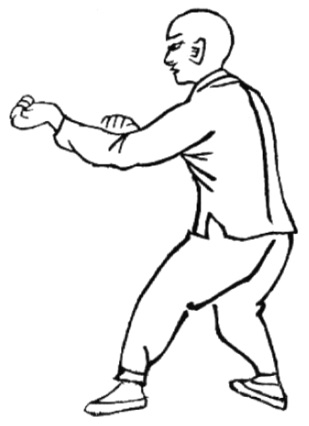
–
五行連環拳譜合璧
A COMBINED VOLUME:
FIVE ELEMENTS MANUAL / CONTINUOUS BOXING MANUAL
深州李存義口述
Dictated by Li Cunyi of Shenzhou [in Hengshui, Hebei]
廣宗杜之堂編錄
Recorded by Du Zhitang of Guangzong [in Xingtai, Hebei]
[circa 1916 (This book has no date on it, but is listed within the 精武本紀 Jingwu Anniversary Book, which itself was published in late 1919. According to that listing, this book was published by the 天津武士會 Warriors Association of Tianjin, which was established in 1912. Compromising between these two dates, 1916 seems reasonable for the time being.)]
[translation by Paul Brennan, Oct, 2017]
–
五行拳譜
MANUAL FOR THE FIVE ELEMENTS TECHNIQUES
–
第一章 總論
CHAPTER ONE: GENERAL INTRODUCTION
第一節 五行解
Section One: Explanation of the Five Elements
五行者金木水火土也內有五臟外有五官皆與五行相配心屬火脾屬土肝屬木肺屬金腎屬水此五行之隱於內者目通肝鼻通肺舌通心耳通腎人中通脾此五行之著於外者五行有相生之道焉金生水水生木木生火火生土土生金又有相克之義焉金克木木克土土克水水克火火克金五行見於洪範而漢儒借之以解經後人每譏其於義無取而生克之理究不為不當也拳之以是取名用以堅實其內整飭其外取相生之道以為平時之習練取相克之義以為對手之破解云爾非必沾沾於古說也
The five elements are metal, wood, water, fire, and earth. Internally there are five major organs and externally there are five senses. All of these things are paired with the five elements. The heart corresponds with fire. The spleen corresponds with earth. The liver corresponds with wood. The lungs corresponds with metal. The kidneys corresponds with water. This is the five elements hidden within. The eyes are connected to the liver, the nose is connected to the lungs, the tongue is connected to the heart, the ears are connected to the kidneys, and the Renzhong acupoint [between nose and upper lip] is connected to the spleen. This is the five elements functioning externally.
The five elements have a method of generating each other: metal gives rise to water, water gives rise to wood, wood gives rise to fire, fire gives rise to earth, and earth gives rise to metal. There is also the method of how they control each other: metal overcomes wood, metal overcomes earth, earth overcomes water, water overcomes fire, and fire overcomes metal.
The five elements concept first appeared in the Hong Fan [“flood model”] document [Book of Documents, document 32], which was then used by Han Dynasty scholars as a way to interpret the world. Later generations mocked the theory because they no longer understood it, however, but the principle of the elements generating and overcoming each other is never unworthy of study. The five elements are after all where these boxing techniques get their name. Make use of them to be solid internally and in good order externally. The method of them generating each other has to do with the solo practice. The concept of them controlling each other helps make sense of the partner practice. It is not necessary here to go more deeply into the ancient explanations.
第二節 五拳解
Section Two: Explanations for the Five Techniques
崩鑽劈礮横五拳之名稱也崩拳之形似箭性屬木礮拳之形似礮性屬火横拳之形似彈性屬土劈拳之形似斧性屬金鑽拳之形似電性屬水由相生之說論之故横拳能生劈拳劈拳能生鑽拳鑽拳能生崩拳崩拳能生礮拳礮拳能生横拳也萬物生於土故横拳能生各拳由相克之說論之故劈拳能克崩拳崩拳能克横拳横拳能克鑽拳鑽拳能克礮拳礮拳能克劈拳也
The five techniques are: crashing, drilling, chopping, blasting, and crossing. Crashing is like an arrow, and so it is associated with wood. Blasting is like a cannon, and so it is associated with fire. Crossing is like a springiness, and so it is associated with earth. Chopping is like an ax, and so it is associated with metal. Drilling is like an electric shock, and so it is associated with water.
They generate each other in this way: crossing can generate chopping, chopping can generate drilling, drilling can generate crashing, crashing can generate blasting, and blasting can generate crossing, All things are born of the earth, therefore crossing can also generate all the other techniques. They overcome each other in this way: chopping can overcome crashing, crashing can overcome crossing, crossing can overcome drilling, drilling can overcome blasting, and blasting can overcome chopping.
第三節 四梢說
Section Three: Explanation of the Four Antennas
人有血肉筋骨血肉筋骨之末端曰梢蓋髮為血梢舌為肉梢爪為筋梢牙為骨梢四梢用力則可變其常態而令人畏懼焉
The body has blood, muscles, sinews, and bones. The endpoints of these tissues are called “antennas”. The antenna of the blood is the hair, the antenna of the muscles is the tongue, the antenna of the sinews is the nails, and the antenna of the bones is the teeth. When the four antennas express power, they can transform you into something unearthly, transmitting to the opponent that he should fear you.
一 血梢:
1. The Blood’s Antenna
怒氣填膺豎髮衝冠
血輪速轉敵膽自寒
毛髮雖微摧敵何難
Filled with a rage,
your hairs will stand on end.
With your blood clearly quickened,
the opponent will tremble in fear.
Even though hairs are so small,
they have no trouble in wrecking the opponent’s morale.
二 肉梢:
2. The Antenna of the Muscles
舌捲氣降雖山亦撼
肉堅比鐵精神勇敢
一舌之威落魄喪膽
Curl your tongue upward and energy will descend,
and then even mountains will be shaken to pieces before you.
Your muscles will be hard as iron
and your spirit will be filled with courage.
With a single powerful action of your tongue [completing a potent energy circuit],
the opponent will lose heart and be scared to death.
三 筋梢:
3. The Antenna of the Sinews
虎威鷹猛以爪為鋒
手攫足蹋氣力兼雄
爪之所到皆可奏功
With the might of a tiger and the fierceness of an eagle,
treat your nails as sharp weapons.
Your hands seize and your feet trample,
both with an energy of boldness.
No matter where you put your claws,
you will win.
四 骨梢:
4. The Antenna of the Bones
有勇在骨切齒則發
敵肉可食皆裂目突
惟牙之功令人恍惚
Courage lies in the bones
and expresses in the teeth.
The opponent’s flesh looks yummy,
says your glaring eyes.
Baring your teeth
will make him quite unnerved.
第四節 八字訣
Section Four: The Eight Terms
四梢之外又有八字拳勢一跕八字具備皆所以蓄力養氣使敵我者失所措也此亦五行拳所特有者八字之名稱一曰頂二曰扣三曰圓四曰毒五曰抱六曰垂七曰曲八曰挺而八字又各有三事都二十四事分述之如左
Beyond the four antennas, there are also the eight terms. Once you have settled into the boxing postures, you are ready for the eight terms. They are all a means of storing power and nurturing energy, keeping one who would fight against you from having a way to get started. They are special qualities of the Five Elements techniques. The eight terms are: 1. pressing, 2. covering, 3. roundness, 4. cruelty, 5. wrapping, 6. lowering, 7. bending, 8. straightening. Each of the eight is divided into three parts. All twenty-four of these items are explained individually below:
一 三頂
1. Three Pressings
頭上頂有衝天之雄手外頂有推山之功舌上頂有吼獅吞象之容是謂三頂
[i] Your head presses upward with the brashness to pierce the sky.
[ii] Your hands press outward with the ability to push over a mountain.
[iii] Your tongue presses upward and thereby you have the power of a lion roaring as if to gulp down an elephant.
二 三扣
2. Three Coverings
肩扣則氣力到肘掌扣則氣力到手手足指扣則周身力厚是謂三扣
[i] Your shoulders cover, and thus power reaches your elbows.
[ii] Your palms cover, and thus power reaches your hands.
[iii] Your fingers and toes cover, and thus power will fill your whole body.
三 三圓
3. Three Roundnesses
脊背圓則力催身前胸圓則兩肱力全虎口圓則勇猛外宣是謂三圓
[i] With your spine rounded, power will urge your body.
[ii] With your chest rounded, your forearms will be filled with power.
[iii] With the tiger’s mouths rounded, bold fierceness will be outwardly shown.
四 三毒
4. Three Cruelties
心毒如怒狸攫鼠眼毒如覷兎之飢鷹手毒如捕羊之餓虎是謂三毒
[i] Your mind is cruel, like an angry fox seizing a rat.
[ii] Your eyes are cruel, like a hungry hawk spotting a rabbit.
[iii] Your hands are cruel, like a hungry tiger catching a sheep.
五 三抱
5. Three Wrappings
丹田抱氣氣不外散膽量抱身臨變不變兩肱抱肋出入不亂是謂三抱
[i] Your elixir field wraps your energy so that it does not scatter away.
[ii] Courage wraps your body so that you will face changes in a situation unfazed.
[iii] Your elbows wrap your ribs so that you may attack and withdraw without falling into disorder.
六 三垂
6. Three Lowerings
氣垂則氣降丹田肩垂則肩催肘前肘埀則兩肱自圓是謂三垂
[i] Energy lowers, thereby descending to the elixir field.
[ii] Your shoulders lower and thereby urge your elbows forward.
[iii] Your elbows lower and thereby give a natural roundness to your arms.
七 三曲
7. Three Bendings
兩肱宜曲曲則力富兩股宜曲曲則力凑手腕宜曲曲則力厚是謂三曲
[i] Your arms should be bent. Then power will be abundant.
[ii] Your legs should be bent. Then power will be collected.
[iii] Your wrists should be bent. Then power will be full.
八 三挺
8. Three Straightenings
挺頸則精氣貫頂挺腰則力達四梢挺膝則氣恬神壹是謂三挺
[i] When your neck straightens, energy will course through to your headtop.
[ii] When your torso straightens, power will arrive at the four antennas.
[iii] When your knees straighten, your energy will be calm and your mind will be focused.
–
第二章 分論
CHAPTER TWO: DESCRIPTIONS OF EACH TECHNIQUE
第一節 開勢
Section 1. BEGINNING POSTURE
五行拳用法最精密由身而肩而肱而手而指而股而足而舌而肛門莫不有說焉分條列之於左
The Five Elements techniques are to be performed with great precision. The body, shoulders, forearms, hands, fingers, thighs, feet, tongue, and tailbone are all involved. Each of these parts is described below:
一 身:
i. Body
前俯後仰其勢不勁
左側右欹皆身之病
正而似斜斜而似正
If you lean forward or back,
the posture will have no power.
To lean to either side
is an error for the whole body.
Be upright but seem to be at an angle,
and be angled but seem to be upright.
二 肩:
ii. Shoulders
頭欲上頂肩須下埀
左肩成坳右肩自随
身力到手肩之所為
Your head wants to press upward,
but your shoulders have to hang down.
Your left shoulder twists in
and your right shoulder naturally goes along with it.
When the strength of your body reaches your hands,
your shoulders are where it is transmitted from.
三 肱:
iii. Forearms
左肱前伸右肱在肋
似曲不曲似直不直
曲則不遠直則少力
Your left forearm is extended forward
and your right forearm is at your ribs.
[Your front arm] seems bent but not bent,
straight but not straight.
If too bent, it has no reach,
and if too straight, it has little power.
四 手:
iv. Hands
右手在脇左手齊心
後者微搨前者力伸
兩手皆覆用力宜多
Your right hand is at your ribs
and your left hand is at solar plexus level.
Your rear hand slightly presses in
and your front hand strongly reaches out.
Both hands turn over to be facing downward,
and should do so with much power [equal force].
五 指:
v. Fingers
五指各分其形似鈎
虎口圓開似剛似柔
力須到指不可强求
The fingers are all spread apart
and the shape is like a hook.
The tiger’s mouth is rounded and open,
and there seems to be hardness and yet softness.
Power has to reach the fingers,
but must not be forced to be there.
六 股:
vi. Thighs
左股在前右股後撑
似直不直似弓不弓
雖有支絀每見雞形
Your left thigh is forward
and your right thigh supports behind.
[Your front leg] seems straight but not straight,
bent but not bent.
With one leg supporting while the other sticks out,
it always looks like a chicken.
七 足:
vii. Feet
左足直出欹側皆病
右足勢斜前踵對脛
二尺距離足指扣定
Your left foot goes out pointing straight,
it being an error to have it turned out to the side.
Your right foot is pointing diagonally,
the front heel aligned with the rear ankle.
There is a distance of two feet between your feet,
and the toes are firmly covering.
八 舌:
viii. Tongue
舌為肉梢捲則氣降
目張髮立丹田愈壯
肌肉如鐵內堅腑臟
The tongue is the antenna of the muscles
and is curled upward for energy to descend.
Your eyes will widen, your hairs will stand,
and your elixir field will be boosted.
Your muscles will be like iron
and your internal organs will be strengthened.
九 肛:
ix. Tailbone
提起肛門氣貫四梢
兩骽繚繞臀部肉交
低則勢散故宜稍高
Tuck in your tailbone
and then energy will course through to the four antennas.
Your legs will be rounded
and your buttocks will squeeze together.
If your tailbone is sticking out, the posture will be in disarray,
therefore it should be slightly tucked in.
用勢不惟五拳開始用之各拳用者甚夥宜熟讀九歌以自練習
Performing the techniques is not just a matter of the five techniques. The beginning posture is used with each of them and its functions are many. You should memorize these nine poems and then the practice will be natural.
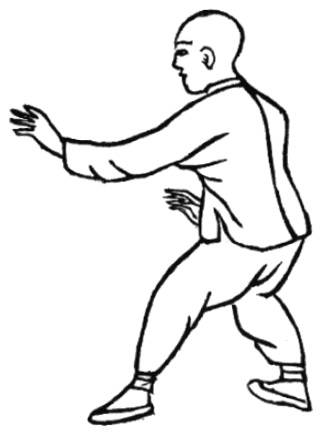
第二節 劈拳
Section Two: CHOPPING
一 路線
1. Footwork
形意與諸拳不同者前脚先進後脚必跟也拳之用也宜速進前脚則便捷靈敏必能取勝拳之進也宜猛跟後脚則氣催身往必不可當不惟劈拳然也劈拳之路線三步為一組前脚進為一後脚進為二旣進之脚復跟為三如下圖
What makes Xingyi different from other boxing arts is that when the front foot advances, the rear foot will follow. When performing a technique, your front foot should quickly advance. You will thus be so nimble and agile that you will always be able to win. When advancing, your rear foot should fiercely follow. Thereby energy will urge your body on and nothing will be able to stand against you, and this is not only true for the chopping technique. The footwork of chopping is to make three steps with each performance of the technique: 1. your front foot advances, 2. your rear foot advances, 3. the foot that first advanced now follows. See the diagram:

開勢 beginning posture
一組 1st time 二組 2nd time 三組 3rd time
一 1st step 二 2nd step 三 3rd step
二 起勢
2. Starting
兩手緊握同變陽拳
拳從口出小指翻天
高不過肩力垂左肩
後拳隨出肘置胸前
眼平舌捲氣降丹田
Your hands grasp tightly into fists,
both with the center of the fist facing upward.
Your fists go out from by your mouth,
rotated so that the little finger is upward.
[Your left fist] goes no higher than shoulder level,
the strength in your left shoulder.
Your rear fist goes out following [your front fist],
the elbow placed in front of your chest.
Your gaze is level, your tongue curled upward,
and energy sinks to your elixir field.
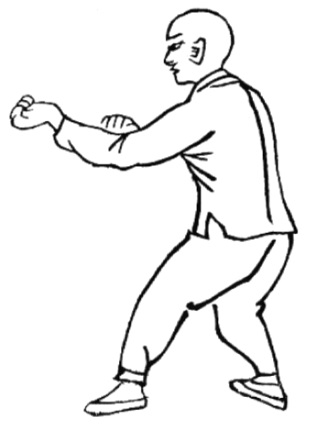
三 落勢
3. Finishing
前脚先開後脚大進
脚手齊落推挽兩迅
後脚斜跟前脚仍順
指開心齊後手脇近
脚手與鼻列成直陣
Your front foot steps out first
and your rear foot advances a large step.
Your feet and hands finish in unison,
one hand pushing out, the other pulling in, both moving quickly.
Your rear foot is at an angle,
but your front is again straight.
[Your front hand] is at solar plexus level, fingers spread,
and your rear hand is near your ribs.
Your feet, hands, and nose
are arranged into a vertical alignment.
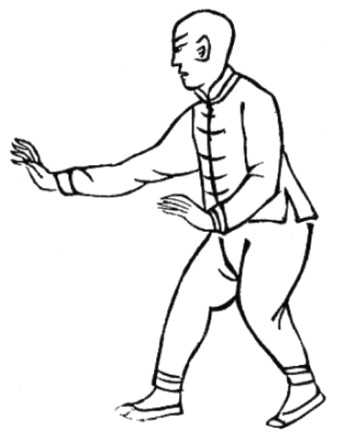
四 回身勢
4. Turning Around
右手在前則左轉身(左手在前則右轉身)前脚在後後脚在前仍然前脚進為一後脚進為二旣進之脚復跟為三如下圖
From your right hand being forward, turn around to the left. (If your left hand was in front, you would turn around to the right.) Your front foot becomes the rear foot and your rear foot becomes the front foot. Then process is as before: 1. the front foot advances, 2. the rear foot advances, 3. the new rear foot follows. See the diagram:

第三節 鑽拳
Section Three: DRILLING
一 路線
1. Footwork
亦以三步為一組與劈拳同
These three steps are the same as for chopping.

二 起勢
2. Starting
左脚前進左掌翻陽
掌凹肱曲如弓斯張
右掌握拳仰置肋旁
眼觀前手銳氣發揚
連接落勢乃不能防
Your left foot advances,
your left palm turning over so the palm is facing upward.
The palm hollows and the elbow bends
so that it is like drawing a bow.
Your right palm grasps in a fist,
the center of the facing upward, and is place beside your ribs.
Your gaze is toward your front hand
and aggressive energy builds.
Then as you continue into finishing,
this technique cannot be defended against.
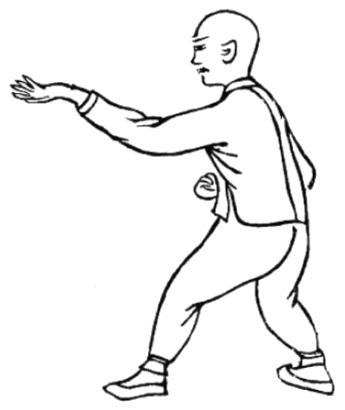
三 落勢
3. Finishing
左脚已開右脚再進
脚落拳鑽覆拳宜迅
左脚斜跟右脚仍順
前拳取鼻後拳肘近
脚手與鼻列成直陣
Your left foot opens outward,
then your right foot advances.
As the foot comes down, your [right] fist drills,
and your [left] fist should turn over rapidly.
Your left foot follows, pointing diagonally,
and your right foot is pointing straight.
Your front fist seeks to be at nose level
and your rear fist has its elbow tight against you.
Your feet, hands, and nose
are all vertically aligned with each other.
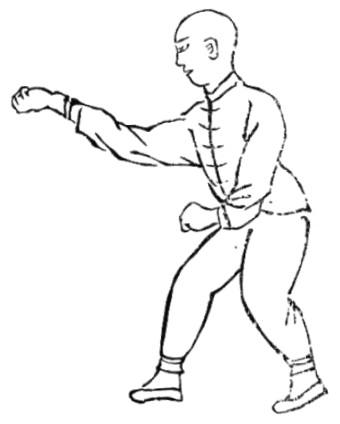
四 囘身勢
4. Turning Around
右手在前則左轉身(左手在前則右轉身)右手自脇邊反出以扣敵腕步法與劈拳同
From your right hand being forward, turn around to the left. (If your left hand is in front, you would turn around to the right.) Your right goes to your [left] ribs, turning over to cover the opponent’s wrist. The footwork is the same as in chopping.

第四節 崩拳
Section Four: CRASHING
一 路線
1. Footwork
崩拳極簡單不能分起落勢而回身較他拳為繁故以出勢回身分叚其鍊法左骽在前右骽脚跟進故亦名左骽崩拳如下圖
The crashing technique is so simple that it cannot be divided into postures of starting and finishing, but its turning around is more complex than for the other techniques, and so its postures are divided into the actions of sending out and turning around. Its practice method involves the left leg being in front and the right foot following forward, hence it is also called LEFT-LEG CRASHING. See the diagram:

二 出勢
2. Sending Out
左脚先開右脚隨進
脛對左踵骽曲勢峻
兩掌變拳後陽前順
順者力挽陽者前奮
兩手互易步法莫紊
Your left foot first goes out,
then your right foot advances.
The ankle is next to your left heel,
and though your legs are bent, the posture stands proudly.
Your palms become fists
and your rear fist goes straight forward, the center of the fist facing to the left.
Your left fist forcefully pulls straight back
as your right fist goes vigorously forward.
Your hands switch places with ease
and your footwork is not in disorder.
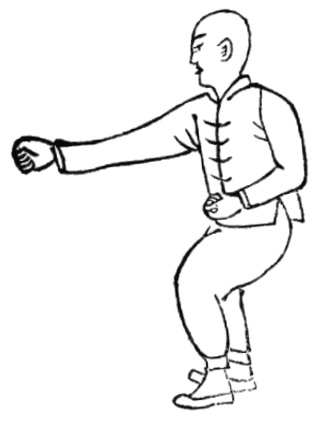
三 回身勢
3. Turning Around
左脚右横隨勢轉身
右脚横提右拳陽伸
左拳抑抱推挽力均
脚手齊落兩掌變陰
後掌左脇前掌齊心
Your left foot turns sideways to the right,
going along with the [rightward] turning of your body.
Your right foot lifts, turning sideways,
your right fist reaching out with the center of the fist facing upward.
Your left fist is wrapping in,
then your hands push and pull with equal force.
Your foot and hands finish in unison,
your palms turning to be facing downward.
Your rear palm is at your left ribs
and your front palm is at solar plexus level.
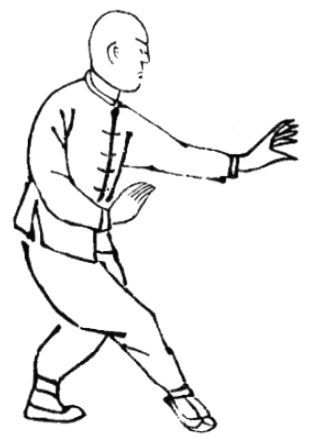
回身線
Footwork for turning around:

囬身 turning around 一組 1st time [along new line]
四 收勢
4. Closing Posture
他拳徑收惟崩拳則於二次囘身後打出則左手在前右骽斜退一步脚横落左骽大退一步斜落骽退時兩手存原勢至左脚落時右手猛撤左手力出名曰退步横拳路線如下
The other techniques are concluded simply, but with the crashing technique, after the second time you turn around and strike out, your left hand then goes forward. Your right leg diagonally retreats a step, the foot coming down sideways, then your left leg retreats a large step. When your right foot comes, your hands stay as they are. When your left foot comes down, your right hand fiercely withdraws and your left hand forcefully goes out. This movement is called RETREAT, CROSSING [movement 3 of the Continuous Boxing set]. See the footwork diagram:

第五節 礮拳
Section Five: BLASTING
一 路線
1. Footwork
劈鑽以三步為一組崩拳以二步為一組礮拳則以四步為一組勢皆斜出如下圖
Whereas chopping and drilling each use three steps, and crashing uses two steps, blasting uses four steps, always moving diagonally. See the diagram:

二 起勢
2. Starting
左脚先進右脚隨之
右斜左提眼觀一隅
掌變陽拳右脇左臍
有如丁字莫亢莫卑
兩肘夾肋舌捲氣垂
Your left foot advances first,
then your right foot follows.
With your right foot pointing diagonally, your left leg lifts,
and your gaze goes to the corner.
Your palms becomes fists, the centers of the fists facing upward,
your right fist at your ribs, your left fist at your navel.
It is like a T shape,
neither hand higher or lower than the other.
As your elbows squeeze your ribs,
curl your tongue upward for energy to descend.

三 落勢
3. Finishing
右拳順出如石之投
左拳裏翻置之眉頭
足提者進與左拳侔
左右互換無用他求
試詳路線如龍如虯
Your right fist goes straight out
like a stone being thrown.
Your left fist turns over inward
as it is placed at your forehead.
Your [left] foot lifts and advances
in unison with your left fist.
The movement is then performed alternating to the left and right
without doing anything else.
Try out the footwork
and you will find it is like a dragon or a serpent.
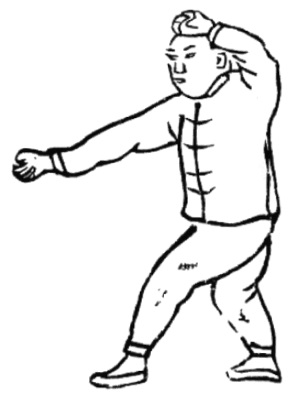
四 回身勢
4. Turning Around
左手出則左轉身(右手出則右轉身)轉時左脚稍動右脚回至左脚地而左脚提起仍斜打譬如路線南北轉身前打東南者轉身後則打東北四隅皆依此類推下為一隅路線圖
From your left hand being forward, turn around to the left. (If your right hand is forward, you would turn around to the right.) When turning, your left foot slightly shifts, your right foot gathers in to be where your left foot was, then your left foot lifts and you again strike out diagonally. The diagram below is aligned north-south. Before you turn around, you are striking to the southeast. After you turn around, you are striking to the northeast. (The rest of the four corners can be deduced from this.) See the diagram below, which shows the stepping to the corners:

第六節 横拳
Section Six: CROSSING
一 路線
1. Footwork
横拳亦用斜勢其步數類劈鑽而非直線其彎曲似礮拳而步數減如下圖
Crossing again uses diagonal stepping. The technique has similarities to chopping and drilling, but is not performed along a straight line. Its winding path is like blasting, but with fewer steps. See the diagram:

二 起勢
2. Starting
前脚提退後脚孤立
兩手成拳前仰後抑
仰者眉齊抑者肘匿
身正眼平卷舌屛息
停峙雖暫宜厚其力
Your front foot lifts and withdraws,
and your rear foot stands one-legged.
Your hands become fists,
the center of your front fist facing upward, your rear fist pressing under its arm.
Your front fist is at eyebrow [shoulder] level
and your rear fist is hidden under its elbow.
Your body is upright, your gaze is level,
your tongue is curled upward, and your breath slows.
Although you pause standing tall for an instant,
you should be filled with power.
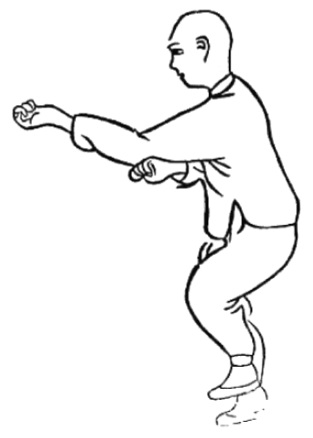
三 落勢
3. Finishing
脚進而落已成翦形
後拳外鑽前拳退行
鑽翻小指退與肘平
下拳横出故以横名
手足變換反用則成
Your [left] foot advances and comes down,
making a scissor shape.
Your rear fist drills outward
and your front fist retreats along its arm.
Your drilling fist turns over so the little finger is upward,
your retreating fist level with its elbow.
The fist that was underneath goes out across,
hence “crossing”.
Your hands and feet alternate
to perform the technique on both sides.
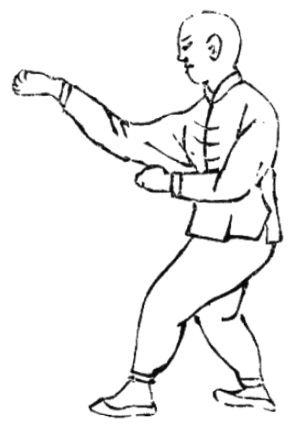
四 回身勢
4. Turning Around
左手出則右轉身(右手出則左轉身)轉時左脚稍動右脚進左脚進拳鑽右脚跟如下圖
From your left hand being forward, turn around to the right. (If your right hand is forward, you would turn around to the left.) When turning, your left foot slightly shifts, then your right foot advances, your left foot advances, your [right] fist drills, and your right foot follows. See the diagram:
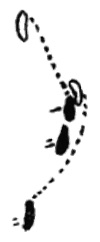
–
第三章 結論
CHAPTER THREE: CONCLUSIONS
第一節 練習
Section One: Practice
一 專練
1. Concentrated Practice
習拳術者對己者十八對人者十二耳故曰壯身者其常勝敵者其暫也專言壯身無論何拳均可習練至於勝敵則五行拳專擅其長焉且勝敵之道貴精不貴多勝一人用此勢勝人人亦可用此勢務博而荒求繁而亂身體無切確之磨練應敵無純熟之技藝此兩失也人情之所樂觀而致意者在濃不在澹在博不在約在急不在緩孤幹無枝之喬松固不若鮮花翠柳之快意迨經酷霜冒嚴雪熟為後凋可斷言矣五行拳皆單勢平時練習之正則也
The practice of boxing arts is eighty percent solo practice, twenty percent partner practice. Thus it is said: “Strengthening the body is constant. Defeating opponents is temporary.” As for strengthening the body, any boxing art can be practiced. As for defeating opponents, the Five Elements techniques are best. A method of defeating opponents requires quality more than quantity. These techniques can be used to fight against one person or many. If you are practicing too many techniques, you will be neglecting all of them. If you strive to have a large amount, you will only end up with a big mess. If your body has not been properly trained, or you try to deal with opponents having not yet achieved skill, in either case you will lose.
It is human nature to devote our attention to what we enjoy. We want things to be full-flavored rather than bland, to be wide-ranging rather than restricted, and to come to us quickly rather than making us wait. A lonely pine tree with a long branchless trunk may not be as pleasing a sight as freshly flowering willows, but which is better at surviving through harsh winter? The Five Elements techniques are all simple postures and are thus the proper thing for ordinary practice.
二 久練
2. Long-Term Practice
深無止境廣無涯涘者惟拳術為然得其淺者一人敵得其最深者何嘗不可萬人敵也習拳固宜虛心而淺嘗輙止忽作忽輟亦不可望其深造且五行拳尤不易為數月己自可觀十年亦非絕藝淺者視之容有後不如前久不如暫者葢熟化之至內力充外力縮也非多厯年所熟復而無間斷未足以臻此極境臻極境者一由於虛心一由於恒性也謂論者恒謂拳術多私每有請而不告告而不盡者夫豈其然其心易滿者或輕試而招禍或好爭而欺人自亡之媒也其性無常者一知半解自視已足朝興暮止自謂己成至於試之無效不曰我師欺我則曰所習己誤是不惟傳授失人而拳術亦為一世所輕矣豈私也哉
“So deep there is no bottom, so vast there is no horizon.” Boxing arts are like this. If you achieve a shallow level, you may be able to deal with one opponent, but if you achieve the deepest level, you will be able to deal with any number of them. To practice boxing arts, you truly have to be humble. If you only take a taste and then stop, working at it sporadically, you cannot expect to get very far. The Five Elements techniques are not at all easy. After just a few months you will see progress, but even after ten years you will still not have mastered them.
A superficial person will look at the contents of the art and feel that the finish line is no better than the starting line, that the long-term achievement is no better than the short-term achievement. However, once your skill has ripened, you will be filled with internal strength, and the tendency toward external strength will have faded. Unless you put many years of uninterrupted work into it, you will not be able to achieve mastery. Mastery comes from two things: humility and perseverance.
Opinionated people keep saying that boxing arts teachers are all selfish, that whenever you ask them something, they will not explain, and whenever they do explain, they do not explain fully. Is this really so? Students who are full of themselves will either recklessly challenge others and invite disaster or they will love to fight so much that they go around bullying people. They are vehicles for their own destruction. Students who are inconstant learn something halfway and then think they know it well enough. They start in the morning, but quit by the evening, and then say they have completed the course. When you test your skill and find out that it is useless, do not say “my teacher cheated me”, say “I practiced it wrong”. It was not that the teacher failed you, it was that you never took the art seriously. How was he being selfish?
第二節 變化
Section Two: Variations
拳雖有五而寔有神妙之功用自其變化言之則劈拳有六鑽礮横各有七崩拳有九共三十六套以下分述之凡前所有者皆列每段之首
Although there are only five techniques, they are indeed ingenious in their function, for they can naturally be adapted. There are six versions of chopping. Drilling, blasting, and crossing each have seven. Crashing has nine. Altogether this makes thirty-six. They are listed below, the versions already appearing in the descriptions above being at the head of each section of the list.
一 劈拳
1. CHOPPING
正步劈拳 進步劈拳 退步劈拳 搖身劈拳 轉身劈拳 捋手劈拳
Straight-step chopping, advance with chopping, retreat with chopping, shaking-body chopping, turning-body chopping, rolling-back chopping.
二 鑽拳
2. DRILLING
順步鑽拳 進步鑽拳 退步鑽拳 搖身鑽拳 轉身鑽拳 拗步鑽拳 捋手鑽拳
Straight-step drilling, advance with drilling, retreat with drilling, shaking-body drilling, turning-body drilling, crossed-step drilling, rolling-back drilling.
三 崩拳
3. CRASHING
左骽崩拳 進步崩拳 退步崩拳 搖身崩拳 轉身崩拳 十字崩拳 順勢崩拳 右骽崩拳 捋手崩拳
Crashing with left leg forward, advance with crashing, retreat with crashing, shaking-body crashing, turning-body crashing, crossed-hands crashing, straight-step crashing, crashing with right leg forward, rolling-back crashing.
四 礮拳
4. BLASTING
拗步礮拳 進步礮拳 退步礮拳 搖身礮拳 轉身礮拳 順步礮拳 捋手礮拳
Crossed-step blasting, advance with blasting, retreat with blasting, shaking-body blasting, turning-body blasting, straight-step blasting, rolling-back blasting.
五 横拳
5. CROSSING
拗步横拳 進步横拳 退步横拳 搖身横拳 轉身横拳 順步横拳 捋手横拳
Crossed-step crossing, advance with crossing, retreat with crossing, shaking-body crossing, turning-body crossing, straight-step crossing, rolling-back crossing.
五行拳譜終
(This concludes the manual for the Five Elements techniques.)
–
連環拳譜
MANUAL FOR THE CONTINUOUS BOXING SET
–
第一章 總論
CHAPTER ONE: GENERAL DISCUSSION
第一節 名稱
Section One: About the Name
變化五行拳合為一套倐進倐退勢皆循環光怪陸離勢皆連貫故謂之連環拳以其進退無常也故又謂之進退連環拳今從簡稱
The transformations of the five elements are merged together into one set, suddenly advancing and suddenly retreating, cycling on and on, a variety of techniques linked together, which is called Continuous Boxing. It changes constantly between advancing and retreating, therefore it is also called Advance & Retreat Continuous Boxing, but is abbreviated in this book for the sake of simplicity.
第二節 練習
Section Two: Practice
連環拳以五行拳為母五拳未能習熟不必學連環拳此拳共有十勢又進退各半雖往復練之範圍亦小是以有引長之法練習於寬地亦不見為短也引長之法前節不轉身至崩拳仍接二勢則往復足四十勢矣
The Continuous Boxing set is based in the Five Elements techniques. If the five techniques have not yet been practiced to familiarity, there is no point in learning the Continuous Boxing set. This set has altogether ten postures [minus the beginning posture and the turning posture], about half of them advancing, half retreating. Although the scope of practicing only back and forth is rather small, it does have the method of reaching far. Practice in a broad space so that the postures do not get shortened. Reach far all the way through the first performance of the postures. Do not turn around until you have performed the final crashing technique, then repeat the movements [going back to where you started]. And then by going back and forth all over again, the set will consist of forty postures.
第三節 應用
Section Three: Application
拳法以應用為主連環拳可以連環用之握之則為拳伸之則為掌故可變為連環掌此徒手之應用也刀槍棍劍無不可用有刃者則砍有鋒者則刺無鋒刃者則打不過手勢之變化耳故器械無論雙單長短大小皆可包括無遺苟明變化之功用何往而不應用哉
Boxing methods are based first of all in application. The Continuous Boxing set can be considered continuous application. A hand rolled up is a fist. A hand extended is a palm. Therefore you may adjust the techniques to being continuous palming, if that is what suits the situation in a fight. Or the techniques can all be done using a saber, spear, staff, or sword. The edge of a blade can be used to chop. The tip of a blade can be used to stab. In the absence of edge or tip, the weapon can be used to strike. These are merely variations on the hand postures. Regardless of the characteristics of the weapon – double or single, long or short, large or small – all of these techniques can be included. If you understand the applicability of adaptability, these techniques can be used in all situations.
第四節 路線
Section Four: Footwork Diagram

開 beginning posture
一 posture 1 二 2 三 3 四 4 五 5 六 6 七 7 八 8 九 9 十 10
–
第二章 分論
CHAPTER TWO: DESCRIPTIONS OF EACH MOVEMENT
第一節 開勢
1. BEGINNING POSTURE
連環拳仍用五行拳之開勢
The Continuous Boxing set uses the same opening posture as with the individual Five Elements techniques.
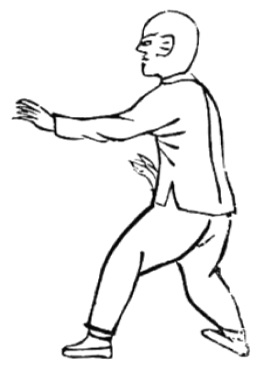
第二節 進步崩拳
2. ADVANCE, CRASHING
由開勢兩手變拳進左骽左拳陰出順落齊心左拳順回陽落齊臍同時右骽隨進脛對左踵提肛兩骽稍絀
From the beginning posture, both hands become fists. Your left leg advances. Your left [right] fist goes straight out, the center of the fist facing to the left, finishing at solar plexus level, and your left fist withdraws straight back, the center of the fist facing upward, finishing at your navel. At the same time, your right leg follows forward so the ankle is next to your left heel. Tuck in your tailbone. Both legs knees slightly stick out.
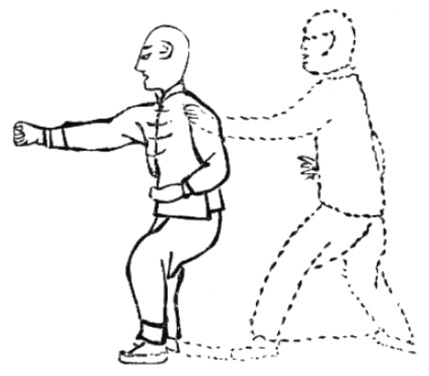
第三節 退步橫拳
3. RETREAT, CROSSING
右骽斜退一步脚橫落左骽大退一步脚斜落右骽退時兩手存原勢至左脚落時右手猛撤齊臍左手力出齊心兩骽翦形故又名翦子步
Your right leg diagonally retreats a step, the foot coming down sideways, then your left leg retreats a large step, the foot coming down diagonally. When your right leg retreats, your hands stay as they are. When your left foot comes down, your right hand fiercely withdraws to your navel and your left hand powerfully goes out at solar plexus level. Your legs are making a scissors shape, hence it is called a “scissor step”.
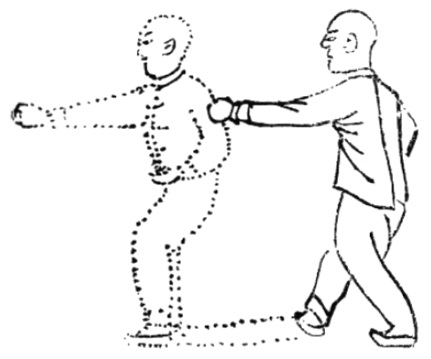
第四節 順步崩拳
4. STRAIGHT STEP, CRASHING
左骽進絀右拳陽出順落齊心左拳順回陽落齊臍左脚稍跟
Your left [right] leg advances, your right fist going straight out, the center of the fist facing to the left, finishing at solar plexus, your left fist withdrawing straight back, the center of the fist facing inward, finishing at your navel. Your left foot slightly follows.
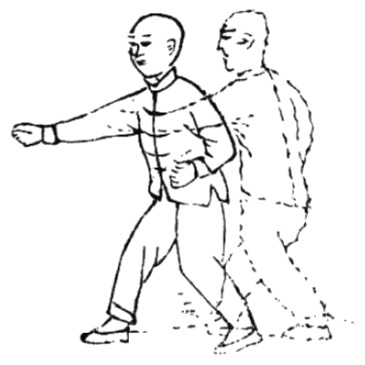
第五節 白鵝亮翅
5. WHITE GOOSE SHOWS ITS WINGS
左骽退兩拳攏至襠成十字卽以原勢上起至額兩拳又各繞半圜至襠左掌右拳力打右骽於上起時撤與左骽並兩骽皆稍絀
Your left leg retreats. Your fists come together to make an X shape which is lifted until at your forehead. Then both fists arc, each making a half circle, until at your crotch, your left palm and right fist forcefully striking together. When your hands rise, your right leg withdraws to stand next to your left leg, both knees slightly sticking out.
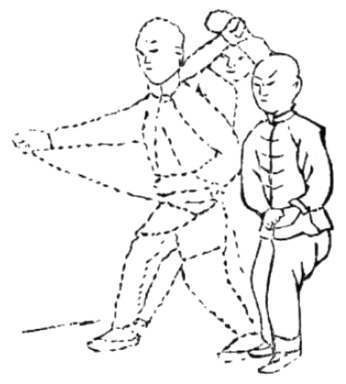
第六節 進步礮拳
6. ADVANCE, BLASTING
右骽進絀左拳出齊心右拳翻上至額是謂拗步礮拳
Your right leg advances, your left fist going out at solar plexus level, your right fist turning over as it goes upward to your forehead. This is called “crossed-step blasting”.
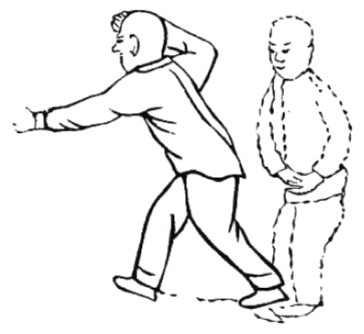
第七節 退步鑽拳
7. RETREAT, DRILLING
右骽大退右掌下落左拳由胸部鑽出左骽退與右脚並兩骽稍絀兩陽掌置臍部左橫右頂
Your right leg retreats a large step, your right fist lowering, your left fist drilling out from your chest. Your left foot retreats to stand next to your right foot, both knees slightly sticking out. Your palms are placed at your navel, both facing upward, left palm flat, right palm supporting underneath.
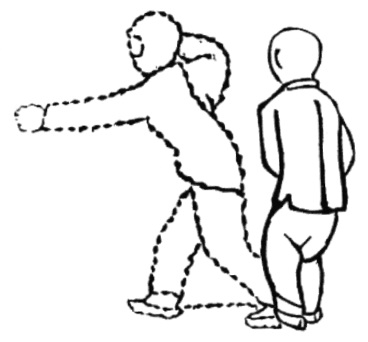
第八節 進步撥掌
8. ADVANCE, DEFLECTING PALM
左骽進左掌外撥右骽右拳皆存原勢眼視掌左骽絀右骽支
Your left leg advances, your left palm deflecting outward. Your right leg and right fist both stay where they are. Your gaze is toward your palm. As your left leg goes out, your right leg supports.
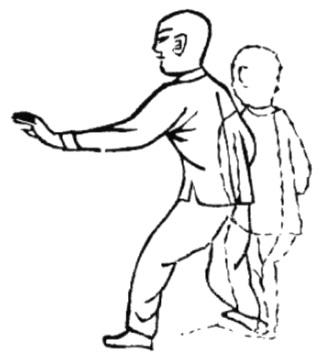
第九節 進步鑽拳
9. ADVANCE, DRILLING
左骽稍進仍絀左掌變拳右拳出小指上翻左拳回撤陽置肋右骽稍跟
Your left leg slightly advances further, your left palm becoming a fist. Your right fist goes out, turning over so the little finger is upward, your left fist withdrawing to your ribs, the center of the fist facing upward, as your right leg slightly follows.
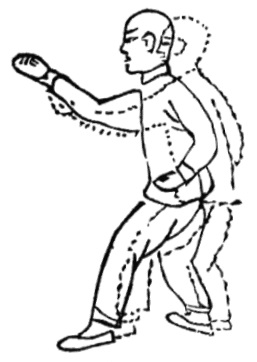
第十節 拗步劈拳
10. CROSSED STEP, CHOPPING
左骽進兩拳陽置胸前左上右下右脚橫落左掌覆推右掌覆挽眼視前掌俗稱狸貓上樹
Your left leg advances, both fists being placed in front of your chest, the centers of the fists facing upward, left fist above, right fist below. Your right foot comes down sideways, your left palm turning over and pushes out, your right palm turning over and pulling in. Your gaze is toward your front palm. This is commonly called LEOPARD CLIMBS THE TREE.
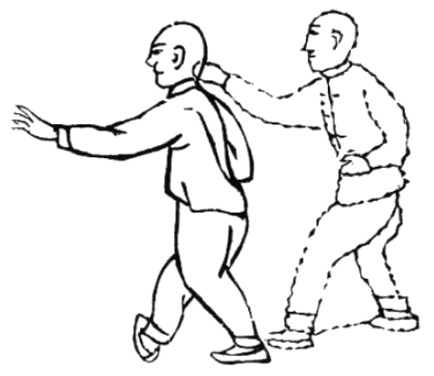
第十一節 進步崩拳
11. ADVANCE, CRASHING
兩手變拳右脚順進左骽大進右拳陰出順落齊心左掌順回陽落齊臍右骽隨進脛對左踵提肛兩骽稍絀
Both hands becoming fists, your right foot advances straight ahead and your left leg advances a large step. Your right fist goes out straight ahead, the center of the fist facing to the left, finishing at solar plexus level, your left fist withdrawing straight to your navel, the center of the fist facing inward. Your right leg follows forward so the ankle is next to your left heel. Tuck in your tailbone. Both knees slightly stick out.
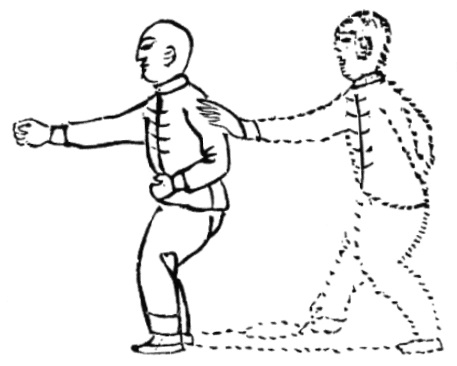
第十二節 回身勢
12. TURNING AROUND
左脚右橫隨勢轉身
右脚橫提右拳陽伸
左拳抑抱推挽力均
脚手齊落兩掌變陰
後掌在脇前掌齊心
Your left foot turns sideways to the right,
going along with the turn of your body.
Your right foot lifts up sideways,
your right fist extending with the center of the fist facing upward.
Your left fist is wrapped in, the center of the fist facing upward,
then your hands push and pull with equal force.
Your [right] foot coming down as your hands finish,
your palms turning over to be facing downward.
Your rear palm is at your ribs,
your front palm at solar plexus level.
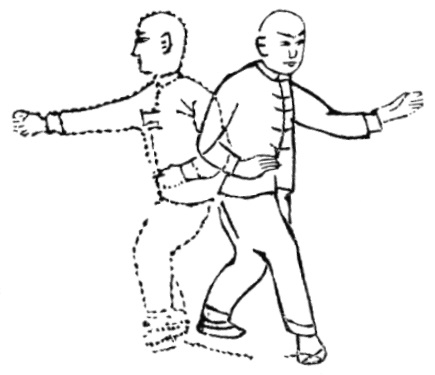
連環拳譜終
(This concludes the manual for the Continuous Boxing set.)
–
–
–
![]()